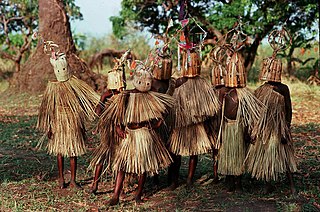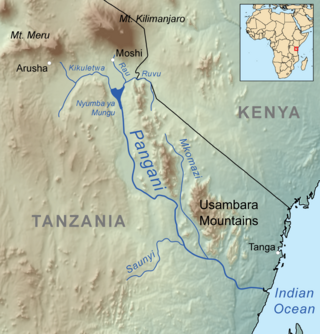19th century
In the early 1800s, there were a number of Nyamwezi kingdoms, such as Unyanyembe, Ulyankhulu and Urambo. Unyanyembe was perhaps the most powerful, since it controlled the trading city of Tabora, and had close connections with the Arabs of Zanzibar, through the Arab community of Tabora. When Mnywasele inherited the throne of Unyanyembe in 1858, the Arabs helped him expel his rival Mkasiwa, who went into exile in Ulyankhulu. When Mnywasele later tried to increase his control over the Unyanyembe trading community, those allied with Mkasiwa, which led to a greater conflict between Unyanyembe and Ulyankhulu in 1860. The result of the conflict was that Mkasiwa gained the throne of Unyanyembe. In 1871 Unyanyembe was involved in another war, this time against Urambo, which at this time was ruled by the slaver and ivory trader known as Mirambo. 1873 the Urambo forces blockaded the ivory trade from Tabora resulting in the price of ivory rising globally. [4] The war lasted until Mirambo's death in 1884. [5]
In the 19th century, settlements were described as typically large, compact, and fortified for defense with strong wooden stockades, often in high inaccessible rocky places. When the Germans finally imposed peace, the population did not immediately disperse, but slowly, over a fifty-year period, the modern pattern of scattered settlements emerged.
German colonialists controlling Tanzania from the late 19th century (calling it German East Africa), found the Nyamwezi heavily involved in trade relations with the Arabs and the island of Zanzibar, dominating as traders and porters since 1850. (While Iliffe lists a likely 100,000 people traveling to and from the coast, Abrahams lists a possible 200,000 using many of the side 'roads', some making the trip as many as 20 times.) Despite the Nyamwezi's outside contacts, Nyamwezi colonies were remarkably resistant to foreign culture. Nyamwezi colonies outside the Unyamwezi long remained culturally distinct. In Unyamwezi itself, differing lifestyles were either absorbed into the existing order, similar to the Ngoni becoming just another chiefdom, or became isolated like the Arabs of Tabora. But for all their poor relationships with the coast and their conservatism, being able to travel was considered a valuable and manly attribute.
Many trade routes crossed Unyamwezi, and the Nyamwezi had access to ivory and slaves, stretching from the coast to the inland, as far as Congo. The western Nyamwezi arrived at the coast with ivory around 1800, and coastal traders soon followed this up by finally entering Unyamwezi and reaching Ujiji by 1831. A kind of California Gold Rush took place for the ivory of the Congo's Manjema to the west of Lake Tanganyika. With their deep involvement in commerce, the Nyamwezi welcomed traders. The most hospitable chiefdom was Unyanyembe, where Arab traders established the nexus of Tabora to the Lake district beyond.
Conflicts between chiefs and Arab traders lasted through the last half of the 19th century. Chiefs such as Isike and Mirambo, no longer being purely ritual, had found that the arrival of firearms enabled them to create standing armies and a new state organization. It was firearms and trade that transformed the region, for trade generated the wealth needed to obtain firearms. Chiefs were normally ritual figures who had no very rigid rules of succession. They lived very restricted lives, with the most significant duties being carried out by headmen. They were strangled when they became seriously ill (as probably happened to Mirambo while dying of cancer), for the well being of the state and its continuation was identified with chief and his subordinate administrators. A hierarchy of territorial offices came into being. There were sub-chiefs, assistant chiefs, headmen elders, ritual officials, etc., as each dynasty seized power from another. Greater Nyamwezi had become a war zone.
By 1890 the Germans advanced further towards Tabora the western part of Tanganyika. It is located in the interior of Nyamwezi land. There, they met stiff resistance from Isike the Unyanyembe hereditary ruler. Isike was the only leader in Nyamweziland who was prepared to defend his country to the last drop of blood.
According to European intelligence and correspondence information provided by missionaries and explorers, Isike was on top the German list of serious opponents of the Europeans. With the coming of the Germans Isike was going to be alone—his Arab allies caved in, they abandoned the long relationship they had from the time of Isike's father Mkasiwa. The Arabs recognised and acknowledged the European military power they sided with them in the war against Isike.
Isike was a committed ruler who dedicated his life to longevity of his Nyanyembe state. He was attentive on matters of state governance. A man of few words. In communication with people he listened more than talking.
Isike was prudent in his dealings with all foreigners. His centrist view endeavoured to strike the middle way to balance the triangular relationship in the caravan trade. The triangular power relations between 1. local rulers, 2. Arab-Indians and 3. Europeans. His awareness and knowledge of the power workings of the three sides of the triangle sustained his authority.
In anticipation of foreign invasions Isike constructed a fortress around the Nyanyembe royal courts in Itetemia. It was a purpose built defence stronghold to keep invaders at bay. Built with thick walls built with stones and mud mortar, strengthened with fire. The walls were approximately three feet in width and ten feet in height. At the top of the walls holes were curved strategically designed for ruga-ruga snipers to place weapons in defence of the fortress base.
Unlike Isike's contemporaries Mirambo and Nyungu-ya-Mawe (Isike's cousin) who participated in the forefront of the battles lines leading their vicious ruga-ruga armies Isike chose to control his ruga-ruga forces from his command centre inside the fortress. He never complied with German demands or invitation to attend supposedly peace talks. Instead, he sent envoys only. He refused to come out of his fortress to personally negotiate with the invaders.
The German's first attempt to pacify Isike failed dismally in 1890. Their small army and weak military equipment was not up to the task. Isike stuck to his tactic of barricading himself in his fortress.
The German authority appointed Lieutenant Tom von Prince specifically to challenge and crash Isike's resistance by any means necessary. This time the Germans were better prepared with the additional reinforcement including the local ruga-ruga deserters who were lured with handsome rewards to work for the Germans as mercenaries. Lieutenant Tom von Prince Military was equipped with better weapons.
He also forged a coalition of the willing deserters, the skilled and experienced Arab militia with the support of princess Nyanso (Isike's rival cousin), and Ruga-ruga from other complying Nyamwezi rulers. The Ruga-ruga mercenaries and Arab militia puppets not only strengthened the German's army personnel in size, they also volunteered all vital intelligence that could undermine Isike's defence strategies.
In 1891 the Germans learnt a bitter lesson when they lost half their troops in Kalenga. Their military was annihilated when they attacked the Hehe ruler Mkwawa—Isike's son-in-law and a staunch ally. The Germans knew the two leaders conspired keeping in close contact and sharing intelligence in their bid to wade off foreign invasion.
Prior to 1893, the Germans launched two major unsuccessful attacks as attempt to defeat Isike and followed with intermittent multiple skirmishes. The Germans third ferocious offensive was decisive big blow. The German military; was able to break into Isike's stronghold. Realising imminent defeat, instead of surrendering to be captured alive by the victors Isike took his life in a suicide. He ignited the remaining gunpowder kegs stocked in the armoury where he barricaded himself with willing relatives and wives. He did not want to live an undignified miserable life under foreign occupiers.
Before Isike's defeat in 1891 Nyanso was installed as the German's allied ruler of Unyanyembe. Isike's death in 1893 cemented German's victory against him. This occurrence sealed the fate of the Nyamwezi dominance of the central caravan trade route. The Germans freely exalted their authority in Unyamwezi lands and subsequently Tanganyika. The German strategy to form a collaborative strong coalition of Isike's enemies, paid off. Otherwise, it would have been a strenuous task. It would have taken the Germans longer to defeat Isike's resolve. Only Isike's brother Swetu openly continued to resist in the periphery.
When Isike's Itetemia fortress fell in the German's hands, his brother Swetu retreated into the miyombo forest terrain with the remaining faithful ruga-ruga platoons. Swetu launched sporadic guerrilla attacks against the German invaders for about two years. However, Swetu's guerrilla tactics were not as organized as Mkwawa's. The German's military effort focused on Mkwawa after the conquest of Unyamwezi.
Unyamwezi was "pacified" by the Germans in 1893; only Chief Isike around Tabora giving any serious opposition. The Germans adopted a form of indirect rule in the region with chiefs becoming the administrative agents of the central government, receiving account books as a formal mark of recognition. Over time, the chiefs were expected to keep order and collect taxes. Where earlier officers welcomed their collaboration, later officers became suspicious of it, even deliberately dismantling a chiefdom.
As late as 1906, Karl Weule, a German ethnolonogist had the following to say; "Even European caravans had their porters expect to receive food and drink from native villages they passed through"
After the Germans were removed from Tabora during World War I, the British took over in 1919 and ruled until the Tanzanian independence of 1961. To combat sleeping sickness, many people were moved into new villages free from the disease. [6]












